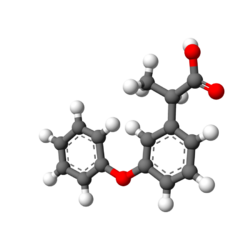Chemistry:Fenoprofen
 | |
 | |
| Clinical data | |
|---|---|
| Trade names | Nalfon |
| AHFS/Drugs.com | Monograph |
| MedlinePlus | a681026 |
| Pregnancy category |
|
| Routes of administration | By mouth |
| ATC code | |
| Legal status | |
| Legal status | |
| Pharmacokinetic data | |
| Metabolism | Major urinary metabolites are fenoprofen glucuronide and 4′-hydroxyfenoprofen glucuronide. |
| Elimination half-life | 3 hours |
| Excretion | Renal (~90%) |
| Identifiers | |
| |
| CAS Number | |
| PubChem CID | |
| IUPHAR/BPS | |
| DrugBank | |
| ChemSpider | |
| UNII | |
| KEGG | |
| ChEBI | |
| ChEMBL | |
| Chemical and physical data | |
| Formula | C15H14O3 |
| Molar mass | 242.274 g·mol−1 |
| 3D model (JSmol) | |
| |
| |
| (verify) | |
Fenoprofen, sold under the brand name Nalfon among others, is a nonsteroidal anti-inflammatory drug (NSAID). Fenoprofen calcium is used for symptomatic relief for rheumatoid arthritis, osteoarthritis, and mild to moderate pain. It has also been used to treat postoperative pain.[1] It is available as a generic medication.[2][3]
Pharmacology
Decreases inflammation, pain, and fever, probably through inhibition of cyclooxygenase (COX-2 inhibitor) activity and prostaglandin synthesis.
Chirality and biological activity
Fenoprofen is chiral drug with one stereogenic center and exists as chiral twins. (S)-enantiomer has the desired pharmacological action where as the (R)-isomer is less active. It is observed that there is stereoselective bioconversion of the (R)- to (S)-fenoprofen. This stereoselective conversion is called chiral inversion.[4][5]
Contraindications
History of significantly impaired renal function; patients with known hypersensitivity to any component of the product; patients who have experienced asthma, urticaria, or allergic-type reactions after taking aspirin or other NSAIDs; treatment of perioperative pain in the setting of coronary artery bypass graft (CABG) surgery.
Adverse effects
In October 2020, the U.S. Food and Drug Administration (FDA) required the drug label to be updated for all nonsteroidal anti-inflammatory medications to describe the risk of kidney problems in unborn babies that result in low amniotic fluid.[6][7] They recommend avoiding NSAIDs in pregnant women at 20 weeks or later in pregnancy.[6][7]
Drug interactions
- Aminoglycosides (e.g. gentamicin): Plasma aminoglycoside levels may be elevated.
- Angiotensin-converting enzyme (ACE) inhibitors: Antihypertensive effect of ACE inhibitors may be diminished.
- Anticoagulants: Coadministration may prolong prothrombin time.
- Aspirin: Fenoprofen Cl may be increased; coadministration is not recommended.
- Diuretics: Patients treated with fenoprofen may be resistant to the effects of loop diuretics and thiazides.
- Hydantoins, sulfonamides, sulfonylureas: Fenoprofen may displace these drugs from their binding site.
- Lithium: Renal Cl of lithium may be reduced and plasma levels may be elevated, which may increase the risk of lithium toxicity.
- Methotrexate: May increase methotrexate levels.
- Phenobarbital: May decrease fenoprofen t1⁄2. Dosage adjustments of fenoprofen may be required if phenobarbital is added or withdrawn.
- SSRIs (e.g. fluoxetine, citalopram): The risk of GI effects may be increased.
Laboratory test interactions
False elevation in free and total serum T 3 as measured by Amerlex-M kit.
Brand names
- UK – Fenopron (Typharm Limited)
See also
References
- ↑ "Single dose oral fenoprofen for acute postoperative pain in adults". The Cochrane Database of Systematic Reviews 2011 (2): CD007556. February 2011. doi:10.1002/14651858.CD007556.pub2. PMID 21328296.
- ↑ "2022 First Generic Drug Approvals". 3 March 2023. https://www.fda.gov/drugs/drug-and-biologic-approval-and-ind-activity-reports/2022-first-generic-drug-approvals.
- ↑ "Competitive Generic Therapy Approvals". 29 June 2023. https://www.fda.gov/drugs/generic-drugs/competitive-generic-therapy-approvals.
- ↑ "Stereoselective inversion of (R)-fenoprofen to (S)-fenoprofen in humans". Journal of Pharmaceutical Sciences 74 (1): 82–84. January 1985. doi:10.1002/jps.2600740122. PMID 3920382.
- ↑ "The metabolic chiral inversion and dispositional enantioselectivity of the 2-arylpropionic acids and their biological consequences". Biochemical Pharmacology 37 (1): 105–114. January 1988. doi:10.1016/0006-2952(88)90762-9. PMID 3276314.
- ↑ 6.0 6.1 "FDA Warns that Using a Type of Pain and Fever Medication in Second Half of Pregnancy Could Lead to Complications". U.S. Food and Drug Administration (FDA) (Press release). 15 October 2020. Retrieved 15 October 2020.
 This article incorporates text from this source, which is in the public domain.
This article incorporates text from this source, which is in the public domain.
- ↑ 7.0 7.1 "NSAIDs may cause rare kidney problems in unborn babies". 21 July 2017. https://www.fda.gov/drugs/drug-safety-and-availability/fda-recommends-avoiding-use-nsaids-pregnancy-20-weeks-or-later-because-they-can-result-low-amniotic.
 This article incorporates text from this source, which is in the public domain.
This article incorporates text from this source, which is in the public domain.
External links
 |

